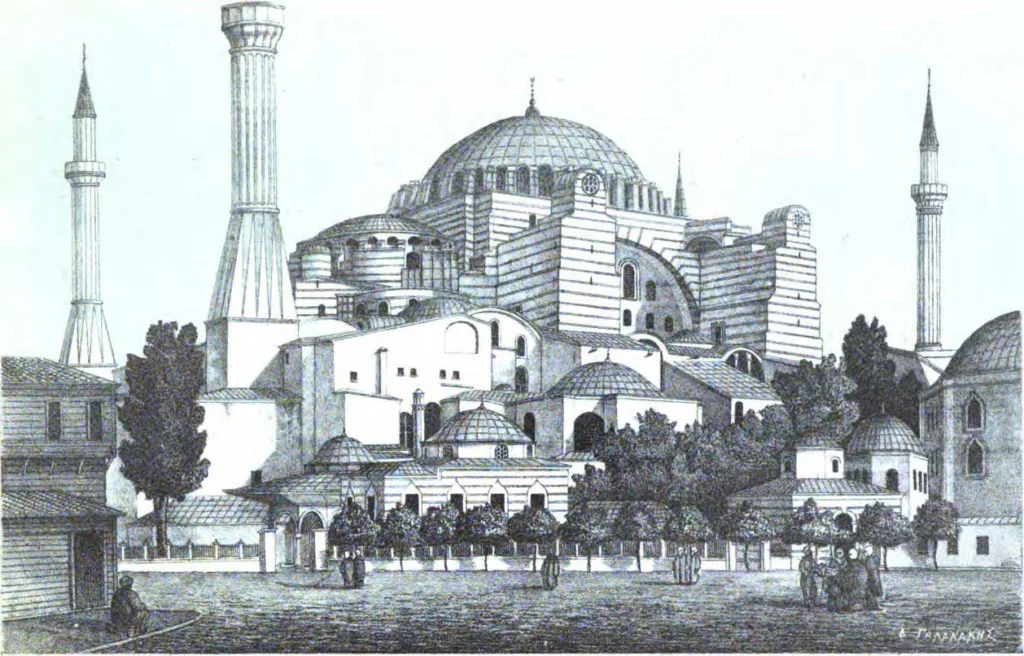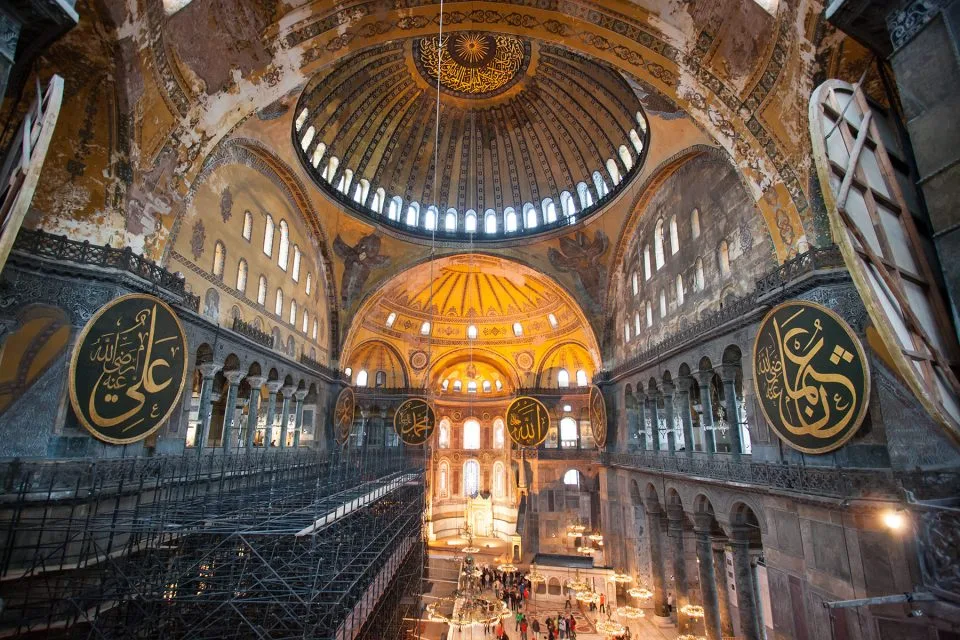What Is the Hagia Sophia?
The Hagia Sophia, known as Ayasofya in Turkish is undoubtedly one of the best sights and attractions in Istanbul. it has a rich history that dates back to its original construction as a basilica for the Greek Orthodox Christian Church. Built by Byzantine Emperor Constantius in 360 A.D., It is one of the best Historical Places in Turkey You Must Visit. the first Hagia Sophia featured a wooden roof and was burned to the ground in 404 A.D. during political conflicts in Constantinople. It was rebuilt by Emperor Theodosios II in 415 with five naves and a monumental entrance but was burned again in the “Nika revolts” during the reign of Emperor Justinian I. Despite the destruction, the basilica was rebuilt yet again, this time with a dome that still stands today. Over the centuries, the Hagia Sophia has served as a church, a mosque, and a museum, and is now once again a mosque. Its architectural significance and cultural importance continue to draw visitors from around the world to Istanbul, Turkey.
What is Hagia Sophia meaning?
The name “Hagia Sophia” comes from the Greek words “hagia” and “sophia” meaning “holy wisdom.”
Hagia Sophia Location
Hagia Sophia’s location is in the heart of Istanbul, Turkey, making it easily accessible to visitors from all over the world.
Located in the Sultanahmet area of the city, it is in the old town and within walking distance from many hotels in the area. Its close proximity to the Topkapi Palace makes it an ideal destination for tourists looking to explore the rich history and culture of Istanbul. The distance from Istanbul International Airport is 20km, and visitors can easily reach Hagia Sophia by taking the Metro or Light Tram lines. The closest tram station is “Sultanahmet station,” and from there, the iconic landmark is just a short walk away.
To avoid long lines and save time, it is recommended to buy tickets online or have your hotel book them for you. If you do choose to wait in line, it’s recommended to arrive early in the morning before the museum opens. Visitors arriving by cruise can exit left from the port along the street with the tram lines, which will lead them straight to Hagia Sophia. For those planning to visit other museums and palaces in Istanbul, it’s worth considering purchasing a museum pass to save time and money.
The History of Hagia Sophia?

Hagia Sophia has a rich and complex history that spans more than 1,500 years. The structure has been the site of political, cultural, and religious upheavals, as well as a showcase for architectural and artistic achievements. Hagia Sophia, located in Istanbul, Turkey, has been a witness to numerous historical events that have shaped the city and the world.
The first Hagia Sophia was built in 360 A.D. by Byzantine Emperor Constantius, and it served as the main church of the Greek Orthodox Christian Church for almost a century. However, this original structure with its wooden roof was destroyed in a fire in 404 A.D.
Emperor Theodosios II rebuilt the church in 415, but it was again destroyed in the Nika Revolt of 532, which was a major riot that resulted in the deaths of thousands of people. The Hagia Sophia was then rebuilt by Emperor Justinian I, and the new structure was completed in 537.
The Hagia Sophia served as the primary church of the Eastern Orthodox Church for nearly a thousand years. It was also the site of important religious and cultural events, including coronations, religious ceremonies, and artistic exhibitions. However, in 1204, during the Fourth Crusade, the Hagia Sophia was looted and damaged by Crusaders, who used the church as their headquarters.
In 1453, Ottoman Sultan Mehmed II conquered Constantinople and converted the Hagia Sophia into a mosque. He added four minarets and covered the Christian mosaics and frescoes with plaster. The mosque remained in use for nearly 500 years, and it underwent several renovations and additions during this time.
In 1935, Turkish President Mustafa Kemal Ataturk converted the Hagia Sophia into a museum as part of his secularization reforms. The plaster was removed, and the mosaics and frescoes were restored, revealing the Christian art and architecture that had been hidden for centuries.
In 2020, Turkish President Recep Tayyip Erdogan converted the Hagia Sophia back into a mosque, which has sparked controversy and protests from both religious and secular groups.
Hagia Sophia Architecture and Interior

Hagia Sophia is an architectural masterpiece, measuring 269 feet in length and 240 feet in width. Its grand domed roof is towering 180 feet above the ground, making it an awe-inspiring sight for visitors. Originally built as a Christian basilica, it still stands tall as the most significant surviving example of Byzantine architecture.
What makes Hagia Sophia stand out are the intricate details that adorn the building. From the massive columns to the stunning mosaics, the building exudes a sense of grandeur that is unmatched. It is fascinating to see how different elements come together to create a harmonious whole. With its soaring domed roof and magnificent architecture, Hagia Sophia is a testament to the ingenuity of its designers and builders.
Let’s take a close/in-depth look at the details of the architecture and interior of Hagia Sophia
Building Materials:
Hagia Sophia was built using a combination of materials, including brick, marble, and stone. The bricks were used for the exterior walls, while the interior features columns, walls, and floors made from marble and stone. The materials were sourced from all over the Byzantine Empire, including Egypt, Greece, and Asia Minor.
Floor Plan:
The Hagia Sophia has a rectangular floor plan with a large central nave and two side aisles. The nave is flanked by two galleries on either side, which were used by the empress and her court. The narthex, or entrance area, leads to the nave and is located on the western side of the building.
Columns:
The interior of Hagia Sophia is supported by a system of columns and piers. There are a total of 107 columns in the building, each varying in size and material. The columns were originally sourced from ancient Roman temples and other buildings, and were repurposed for use in Hagia Sophia.
Dome:
The most distinctive feature of Hagia Sophia is its massive dome, which has a diameter of 31 meters and a height of 56 meters. The dome is supported by four pendentives, which are triangular-shaped sections of masonry that transition the square shape of the building to the circular shape of the dome. The dome was constructed using a combination of brick and mortar, with a layer of decorative mosaics covering the interior surface.
Mosaics:
Hagia Sophia is renowned for its intricate mosaics, which cover the walls, vaults, and dome of the building. The mosaics were created using a technique called tesserae, which involves small pieces of glass or stone being arranged to create a larger image. The mosaics depict a variety of religious scenes and figures, including the Virgin Mary, Jesus Christ, and various saints and apostles.
Minarets:
After the Ottoman conquest of Constantinople, the Hagia Sophia was converted into a mosque and underwent several changes, including the addition of four minarets, or towers, around the building. The minarets were added to provide a platform for the call to prayer and were built in the Ottoman style using brick and stone.
Interior:
The interior of Hagia Sophia features a mix of Byzantine and Ottoman styles. The original Byzantine elements, such as the mosaics, were left intact after the conversion to a mosque, but new Ottoman elements were also added, such as the mihrab, or prayer niche, and the minbar, or pulpit. The interior also features intricate calligraphy and tile work, with blue and gold being the predominant colors.
Restoration:
Hagia Sophia has undergone several restoration projects throughout its history, including one in the 19th century that involved the removal of the plaster that covered the original mosaics. In 2020, a major restoration project was undertaken to repair damage caused by earthquakes and to strengthen the building’s structural integrity.
Opening hours
opening hours for Hagia Sophia are between 10:00 in the morning and 22:00 in the late evening as of 2023. However, since it is a mosque, it is partially closed to touristic visits during prayer hours.
What is the Best time to visit Hagia Sophia?
The best time to go to Hagia Sophia is in the evening, before closing time. During high season (autumn, spring, with a considerable peak in May) come about 1,5 hours before closing time. During low season (November-March, June-July) there is hardly any queue 2-3 hours before closing time. If you think you may need more time for the visit – come to the museum at the opening (or about 15 minutes before in high season).
Best days of the week for Hagia Sophia’s visit are Wednesday and Thursday.
Try to avoid Friday morning: as the Blue Mosque is closed until 2:30 p.m. on this day, Hagia Sophia sees bigger crowds than the other days of the week.
The busiest months for the visit are April-May and September-October. Plan your visit for another period if possible.
Winter (December-February) is the best time to visit: you’ll hardly need to queue even at peak times.
If you see a waiting line inside Hagia Sophia – it’s the queue for the Wishing column. People make their wishes by rotating their thumb in a complete clockwise circle inside the hole, in the column, at the northwest of the building.
Check the opening hours before going: during “summer hours” the museum closes at 7 p.m., the rest of the year it is open until 5 p.m. The last entry is one hour before the museum’s closing.
FAQ about Hagia Sophia?
As Hagia Sophia is a religious and cultural site, visitors are required to dress modestly. Shorts, skirts, and sleeveless shirts are not allowed. Scarves and shawls are provided at the entrance for visitors who need to cover their heads.
Yes, photography is allowed inside the museum. However, the use of flash is not permitted in some areas, and tripods are not allowed.
No, outside food and drinks are not allowed inside the museum. There is a café and a restaurant inside the museum where visitors can purchase food and drinks.
Yes, Hagia Sophia is wheelchair accessible. There are elevators and ramps available for visitors with disabilities.